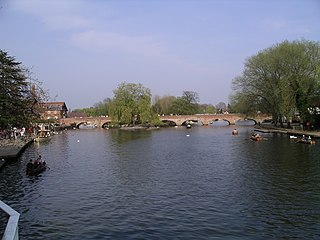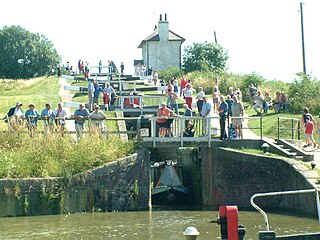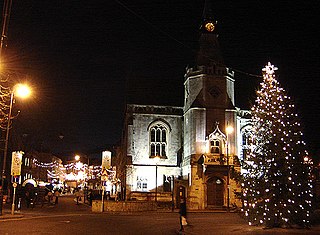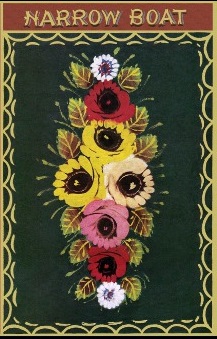
The River Avon, also in central England flows generally southwestwards and is a major left-bank and easternmost tributary of the River Severn. It is also known as the Warwickshire Avon or Shakespeare's Avon, to distinguish it from several other rivers of the same name in the United Kingdom.

The Oxford Canal is a 78-mile (126 km) narrowboat canal in southern central England linking the City of Oxford with the Coventry Canal at Hawkesbury via Banbury and Rugby. Completed in 1790, it connects to the River Thames at Oxford, and links with the Grand Union Canal, which it is combined with for 5 miles (8 km) between to the villages of Braunston and Napton-on-the-Hill.

Banbury is an historic market town on the River Cherwell in Oxfordshire, South East England. It had a population of 54,335 at the 2021 Census.
The I-SPY books are spotters' guides written for British children, particularly successful in the 1950s and 1960s in their original form and again when relaunched by Michelin in 2009 after a seven-year gap in publishing. A search engine set to look for images, with the words - "i-spy" News Chronicle Daily Mail Michelin, can illustrate that a range of styles was used.
Lionel Thomas Caswall Rolt was a prolific English writer and the biographer of major civil engineering figures, including Isambard Kingdom Brunel and Thomas Telford. He is also regarded as one of the pioneers of the leisure cruising industry on Britain's inland waterways, and was an enthusiast for vintage cars and heritage railways. He played a pioneering role in both the canal and railway preservation movements.
Richard Thomas Mabey is a writer and broadcaster, chiefly on the relations between nature and culture.

A gongoozler is a person who enjoys watching activity on the canals of the United Kingdom. The term is also used more generally to describe those who harbour an interest in canals and canal life, but do not actively participate.

The Inland Waterways Association (IWA) is a registered charity in the United Kingdom which was formed in 1946 to campaign for the conservation, use, maintenance, restoration and sensitive development of British canals and river navigations.

William Grundy was an English journalist and broadcaster. As the host of Today, a regional magazine programme on Thames Television in London, he gained national attention for an interview with the Sex Pistols in 1976, during which the band swore and traded insults with him on live television. The interview effectively destroyed Grundy's career, elevated the Sex Pistols to notoriety, and signalled the arrival of mainstream punk rock.

Tackley is a village and civil parish beside the River Cherwell in Oxfordshire, England. It is about 6 miles (10 km) west of Bicester and 4+1⁄2 miles (7 km) north of Kidlington. The village consists of two neighbourhoods: Tackley itself, and Nethercott. The 2011 Census recorded the parish's population as 998.

Ernest Charles Temple Thurston was a British poet, playwright and author.
Louis Davis was an English watercolourist, book illustrator and stained-glass artist. He was active in the Arts and Crafts Movement, and Nikolaus Pevsner referred to him as the last of the Pre-Raphaelites.
David & Charles Ltd is an English publishing company. It is the owner of the David & Charles imprint, which specialises in craft and lifestyle publishing. David and Charles Ltd acts as distributor for all David and Charles Ltd books and content outside North America, and also distributes Interweave Press publications in the UK and worldwide excluding North America, and as foreign language editions. The company distributes Dover Publications and Reader's Digest books into the UK Trade and is also a UK and Europe distribution platform for the overseas acquired companies Krause Publications and Adams Media.

Shipton-on-Cherwell is a village in the civil parish of Shipton-on-Cherwell and Thrupp, in the Cherwell district, in the county of Oxfordshire, England. It is on the River Cherwell about 2 miles (3 km) north of Kidlington in Oxfordshire, England.
The Nicholson Guides are a set of books originally published by Robert Nicholson Publications, then jointly by Bartholomew and the Ordnance Survey, and now by HarperCollins, as guides to the navigable and un-navigable waterways of England and Wales.

Fellows Morton & Clayton Ltd was, for much of the early 20th century, the largest and best-known canal transportation company in England. The company was in existence from 1889 to 1947.

Tooley's Boatyard is a dockyard on the Oxford Canal in the centre of the town of Banbury, Oxfordshire, England.

Banbury is a circa 1,500-year-old market town and civil parish on the River Cherwell in the Cherwell District of Oxfordshire, England. It is 64 miles (103 km) northwest of London, 38 miles (61 km) southeast of Birmingham, 27 miles (43 km) south of Coventry and 21 miles (34 km) north northwest of the county town of Oxford.

The gardens of ancient Egypt probably began as simple fruit orchards and vegetable gardens, irrigated with water from the Nile. Gradually as the country became richer, they evolved into pleasure gardens with flowers, ponds and valleys of fruit and shade trees. Temples, palaces, and private residences had their own gardens, and models of gardens were sometimes placed in tombs so their owners could enjoy them in their afterlife.

Narrow Boat is a book about life on the English canals written by L. T. C. Rolt. Originally published in 1944 by Eyre & Spottiswoode, it has continuously been in print since.















